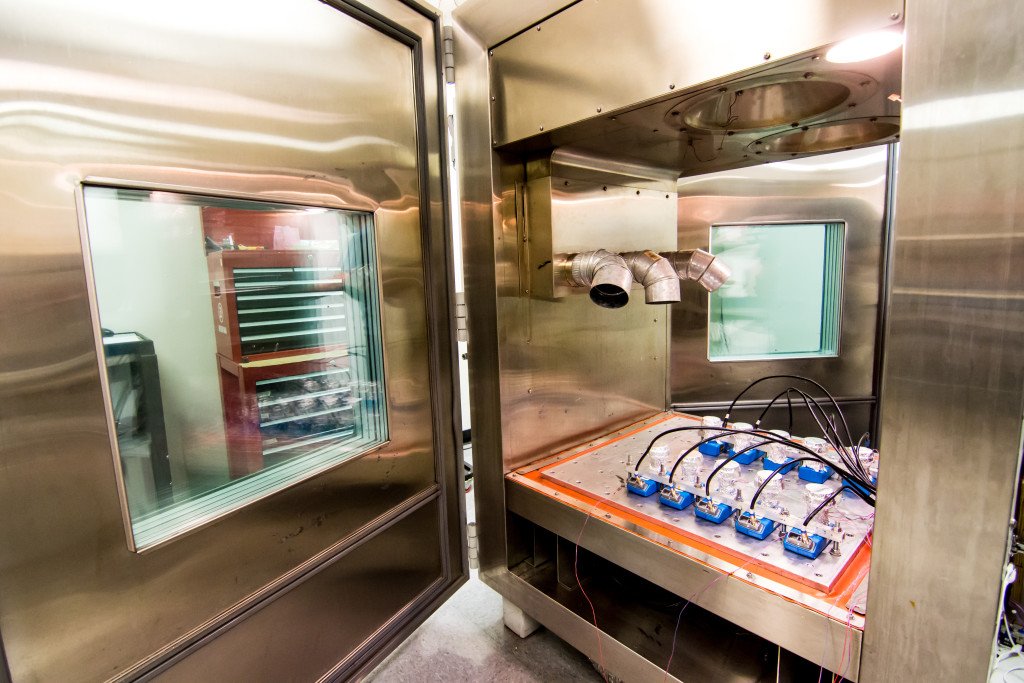What is HALT and how may it benefit my product?
HALT (Highly Accelerated Stress Testing) is a reliability testing method that when facilitated correctly has proven to provide a level of robustness and ruggedization rarely achieved by any other traditional methods of testing. Capitalizing on both singular and synergetic methods of stressors within the same test environment (chamber), latent anomalies have been proven to arise far more rapidly and consistently. The architecture of HALT was designed to simplify root cause failure analysis alleviating the time vs cost paradox to achieve faster design loopbacks. HALT continues to be embraced and then placed into the design process within many industries proving its efficacy.
HALT consists of four fundamental components:
Thermal step stress
Rapid thermal transitions
Vibration step stress
Combined environment
| HALT Testing Steps | HALT Testing Process Anomalies | HALT Testing Process Failures |
|---|---|---|
| 1. Install UUT/s in chamber | Hope not | |
| Thermocouples | ||
| Ancillary Equipment | ||
| 2. Thermal Step | Identify Upper/Lower limits | Decrease/Increase temp to recover |
| Cold (10° C increments) | ||
| Hot (10° C increments) | ||
| 3. Rapid Thermal Transitions | Rapid thermal rate causes contraction/expansion. Identify cold solder joints, inconsistencies in flow. | +/- limits to recover during next cycle |
| 5 cycles of upper/lower limits (+/-) 5° C | ||
| Rapid excursion rate (60° C/min) | ||
| 4. Vibration Step Stress | Exacerbate fluctuations (expansion/contraction) from RTC | Decrease/remove vibration to recover |
| Install fixturing method | Things fall off | Inspect |
| 5 Grms increments | Large components fall off | |
| Up to soft/hard failure | ||
| 5. Combined Environment | Product is mature/robust | |
| 5 cycles of upper/lower thermal limits (+/-) 5° C | Breakdown | |
| 1/5 of vibration operation limit per cycle | Add cycles | |
| Rapid excursion rate (60° C/min) |
Each single stressor step is a precursor to the next synergetic step. Operational and destruct limits are quickly identified, and these limits are then transposed to the next step. Certain facets of HALT have statistically been shown to precipitate failures more rapidly, however each test and device is different. A typical HALT test is 3-4 days depending on the excursion time to equalization, duration of functional testing, and extremes achieved.
HALT leverages upon accumulated stress. It is recommended that each test specimen be exposed to the entire test regimen, even if repair is required. Replacements may be utilized if failures occur, however the data derived from these is not as reliable because stress fatigue is cumulative.
Why should I push my product beyond the expected end user application?
Design for margin and accelerated precipitation of failure(s) can be realized. By pushing a product beyond its expected capabilities, the true maturity of it can be evaluated. Imposing an “over test” situation can result in unrealistic failures. Whereas an “under test” situation can give ambiguous results potentially leading to infant mortality. A comprehensive review of the BOM component derating can provide a relative starting point of how far these limits may be induced within HALT testing if preliminary thermal/vibration characterization is not feasible.
HALT testing performed for client: AT&T
HALT testing setup for client: AT&T
Qualmark HALT chamber characteristics (Typhoon 3.0):
Cavity dimensions: 45”W x 45”D x 35”H
Table size: Up to 36” x 36”, 4” grid pattern; mounting points are 3/8x16
Temperature range: -100°C to +200°C
Transition rate: 60°C/min
Vibration: 5 - 65 Grms (6 DOF broadband, quasi-random, repetitive shock). Single accelerometer control
Access ports: 2-3
Instrumentation: 2 control thermocouples, up to 5 integrated response thermocouples. Additional response thermocouples can be included with ancillary equipment (Fluke 2635A or equivalent)
Is my product a candidate for HALT?
Yes! We test products ranging from consumer electronics, to ventilators, to satellite components, and defense applications. This spectrum of industries illustrates how HALT can be applicable for most if not all devices - from consumable to mission critical. Recalls and sustainable engineering are costly, both financially and in consumer confidence.
So, why is HALT a valuable test for me?
Whether its 5,000 wall mount cameras, 1 ventilator, or a solar array on its way to an obscure galaxy; what level of reliability are you willing to achieve and at what cost?
Most asked question:
Can I calculate MTBF (mean time between failures) from HALT?
No. HALT cannot and will not provide this type of information; By finding all operational and destruct points HALT testing insures the lowest MTBF possible for the product eliminating all design-related random failures in time. The only other random failures or epidemic failures will only be related to manufacturing or supplier part variance. To eliminate those requires a Highly Accelerated Stress Screening technique called HASS.
Next month:
I will delve further into how the HALT environment should be applied, what is expected of the customer to provide/support, sample size, and how the synopsis of the test results can be interpreted and applied.
“There is the testing world, and there is the real world.” - author unknown, often quoted by Eric Gerlach




